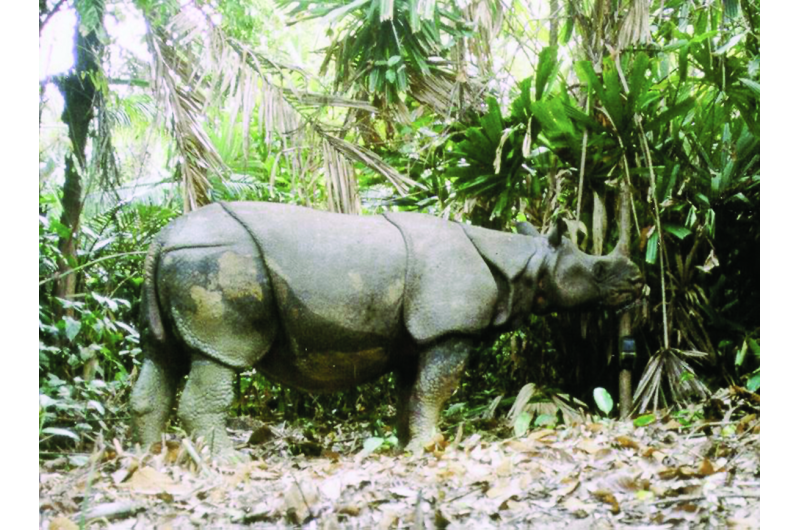Natural disasters pose grave threat to planet's last Javan rhinos

The world's only population of Javan rhinoceros, already under severe threat from poaching, could go extinct in the future due to natural disasters, including volcanic eruptions and tsunamis, according to a new study published in Conservation Letters. The few remaining Javan rhinos live in Ujung Kulon National Park, which is within sight of volcanic Mount Krakatoa and close to the Indonesian Sunda Arc, an area of converging tectonic plates that commonly cause earthquakes, triggering tsunamis.
In the study, a team of international researchers found that the 2013 global population of Javan rhinos was 62 animals, which is likely near the site's current capacity. A tsunami as high as 10 meters, or about 33 feet, which is projected to occur within the next 100 years, could threaten 80 percent of the area in the national park with the highest density of rhinos. As a result, the authors urge the establishment of additional rhino populations away from the reach of natural disasters.
Doing so will require identifying and securing new sites, securing the agreement of numerous stakeholders, including local authorities and the public, and intensive monitoring in Ujung Kulon National Park to determine which individual Javan rhinos may be suitable for translocation.
"What we found in this study provides good momentum for our efforts to save the Javan rhino, considering that we are racing against time," said Arnold Sitompul, conservation director of World Wildlife Fund-Indonesia.
Brian Gerber, postdoctoral fellow at Colorado State University and corresponding author of the study, said that the science shows the need for additional rhino populations to safeguard the species.
"The Javan rhino is the most endangered land mammal in the world," he said. "Now, we need the social and political will to move things forward and establish additional populations."
The study provides a detailed analysis of the Javan rhino population, using an intensive camera trap method. The researchers obtained 1,660 images of rhinos from 178 camera trap locations in 2013 to produce a population estimate of 62 individuals. This compares with an estimate of 25 animals, at most, in 1937.
In addition to the call to build additional populations of rhinos, the study's authors emphasize the importance of taking conservation actions that can help increase the Ujung Kulon National Park's small rhino population numbers, increasing survival odds for at least part of the population in the case of a natural disaster. This includes maintaining strict protection of the remaining rhinos, maintaining the rhino monitoring work, and scaling up ongoing habitat management including controlling Arenga palm, which shades out the forest floor and inhibits the growth of plants that rhinos consume.
"We are proud of the achievements of successful management to boost the Javan rhino population, as revealed in this study," said Ujang Mamat Rahmat, head of Ujung Kulon National Park. "We also have conducted some studies on prospective areas for second habitat, and in the meantime, we will continue to work to improve the security patrols and increase carry capacity through invasive species control."
The International Union for Conservation of Nature Red List of Threatened Species classifies the Javan rhinoceros as critically endangered. The species was extirpated from most of its historical range beginning in the middle of the nineteenth century, primary as the result of excessive demand for rhino horn and other products.
Researchers hope to use the study's findings to revise the Conservation Strategy and Action Plan of Javan rhino, which will expire in 2017.
More information: Ridwan Setiawan et al, Preventing Global Extinction of the Javan Rhino: Tsunami Risk and Future Conservation Direction, Conservation Letters (2017). DOI: 10.1111/conl.12366
Journal information: Conservation Letters
Provided by Colorado State University



















